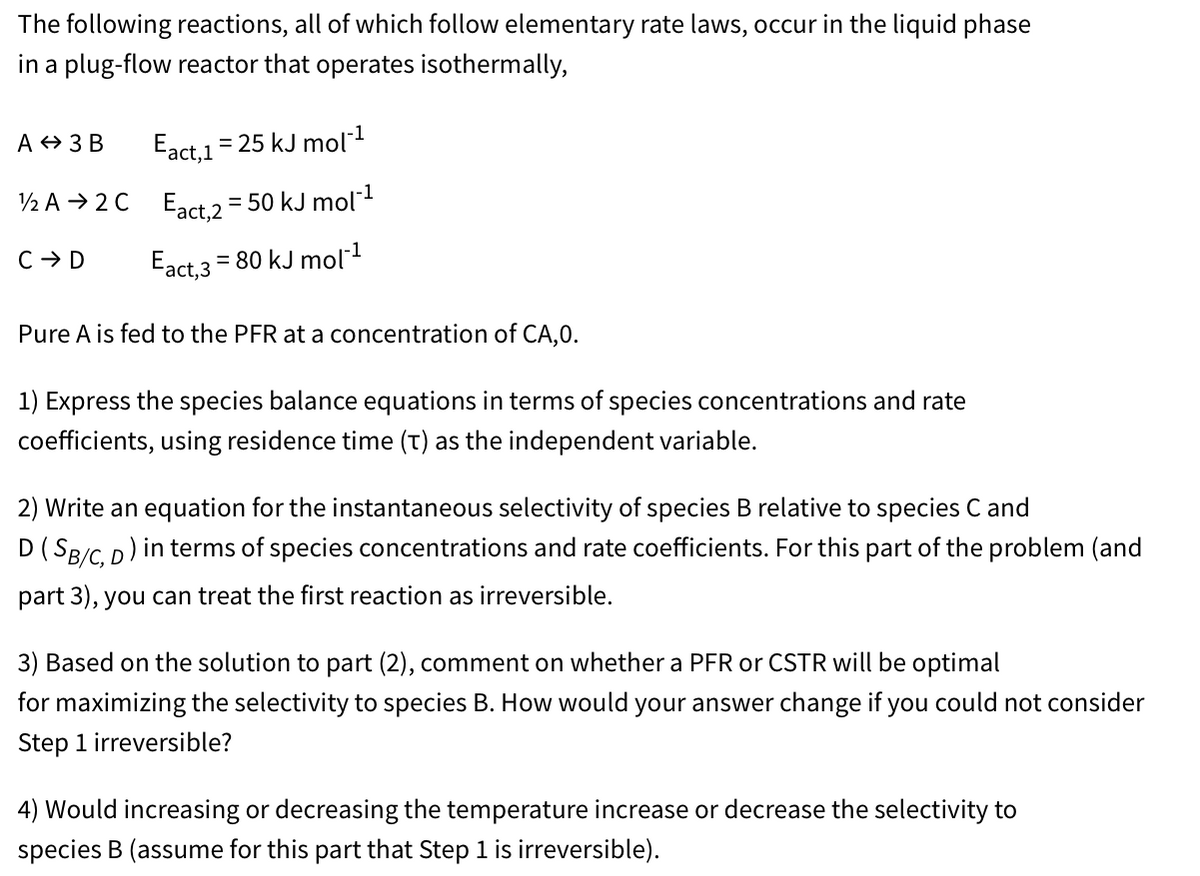The following reactions, all of which follow elementary rate laws, occur in the liquid phase in a plug-flow reactor that operates isothermally, A 3 B Eact, 1 = 25 kJ mol¹ 1/2 A2C Eact, 2 = 50 kJ mol¹ C → D Eact, 3 = 80 kJ mol¹ Pure A is fed to the PFR at a concentration of CA, 0. 1) Express the species balance equations in terms of species concentrations and rate coefficients, using residence time (t) as the independent variable. 2) Write an equation for the instantaneous selectivity of species B relative to species C and D (SB/C, D) in terms of species concentrations and rate coefficients. For this part of the problem (and part 3), you can treat the first reaction as irreversible. 3) Based on the solution to part (2), comment on whether a PFR or CSTR will be optimal for maximizing the selectivity to species B. How would your answer change if you could not consider Step 1 irreversible? 4) Would increasing or decreasing the temperature increase or decrease the selectivity to species B (assume for this part that Step 1 is irreversible).
The following reactions, all of which follow elementary rate laws, occur in the liquid phase in a plug-flow reactor that operates isothermally, A 3 B Eact, 1 = 25 kJ mol¹ 1/2 A2C Eact, 2 = 50 kJ mol¹ C → D Eact, 3 = 80 kJ mol¹ Pure A is fed to the PFR at a concentration of CA, 0. 1) Express the species balance equations in terms of species concentrations and rate coefficients, using residence time (t) as the independent variable. 2) Write an equation for the instantaneous selectivity of species B relative to species C and D (SB/C, D) in terms of species concentrations and rate coefficients. For this part of the problem (and part 3), you can treat the first reaction as irreversible. 3) Based on the solution to part (2), comment on whether a PFR or CSTR will be optimal for maximizing the selectivity to species B. How would your answer change if you could not consider Step 1 irreversible? 4) Would increasing or decreasing the temperature increase or decrease the selectivity to species B (assume for this part that Step 1 is irreversible).
Introduction to Chemical Engineering Thermodynamics
8th Edition
ISBN:9781259696527
Author:J.M. Smith Termodinamica en ingenieria quimica, Hendrick C Van Ness, Michael Abbott, Mark Swihart
Publisher:J.M. Smith Termodinamica en ingenieria quimica, Hendrick C Van Ness, Michael Abbott, Mark Swihart
Chapter1: Introduction
Section: Chapter Questions
Problem 1.1P
Related questions
Question

Transcribed Image Text:The following reactions, all of which follow elementary rate laws, occur in the liquid phase
in a plug-flow reactor that operates isothermally,
A 3 B
Eact, 1
= 25 kJ mol¹
1/2 A2C Eact, 2 = 50 kJ mol¹
C → D
Eact, 3
= 80 kJ mol¹
Pure A is fed to the PFR at a concentration of CA, 0.
1) Express the species balance equations in terms of species concentrations and rate
coefficients, using residence time (t) as the independent variable.
2) Write an equation for the instantaneous selectivity of species B relative to species C and
D (SB/C, D) in terms of species concentrations and rate coefficients. For this part of the problem (and
part 3), you can treat the first reaction as irreversible.
3) Based on the solution to part (2), comment on whether a PFR or CSTR will be optimal
for maximizing the selectivity to species B. How would your answer change if you could not consider
Step 1 irreversible?
4) Would increasing or decreasing the temperature increase or decrease the selectivity to
species B (assume for this part that Step 1 is irreversible).
Expert Solution
This question has been solved!
Explore an expertly crafted, step-by-step solution for a thorough understanding of key concepts.
Step by step
Solved in 2 steps

Recommended textbooks for you

Introduction to Chemical Engineering Thermodynami…
Chemical Engineering
ISBN:
9781259696527
Author:
J.M. Smith Termodinamica en ingenieria quimica, Hendrick C Van Ness, Michael Abbott, Mark Swihart
Publisher:
McGraw-Hill Education

Elementary Principles of Chemical Processes, Bind…
Chemical Engineering
ISBN:
9781118431221
Author:
Richard M. Felder, Ronald W. Rousseau, Lisa G. Bullard
Publisher:
WILEY

Elements of Chemical Reaction Engineering (5th Ed…
Chemical Engineering
ISBN:
9780133887518
Author:
H. Scott Fogler
Publisher:
Prentice Hall

Introduction to Chemical Engineering Thermodynami…
Chemical Engineering
ISBN:
9781259696527
Author:
J.M. Smith Termodinamica en ingenieria quimica, Hendrick C Van Ness, Michael Abbott, Mark Swihart
Publisher:
McGraw-Hill Education

Elementary Principles of Chemical Processes, Bind…
Chemical Engineering
ISBN:
9781118431221
Author:
Richard M. Felder, Ronald W. Rousseau, Lisa G. Bullard
Publisher:
WILEY

Elements of Chemical Reaction Engineering (5th Ed…
Chemical Engineering
ISBN:
9780133887518
Author:
H. Scott Fogler
Publisher:
Prentice Hall


Industrial Plastics: Theory and Applications
Chemical Engineering
ISBN:
9781285061238
Author:
Lokensgard, Erik
Publisher:
Delmar Cengage Learning

Unit Operations of Chemical Engineering
Chemical Engineering
ISBN:
9780072848236
Author:
Warren McCabe, Julian C. Smith, Peter Harriott
Publisher:
McGraw-Hill Companies, The